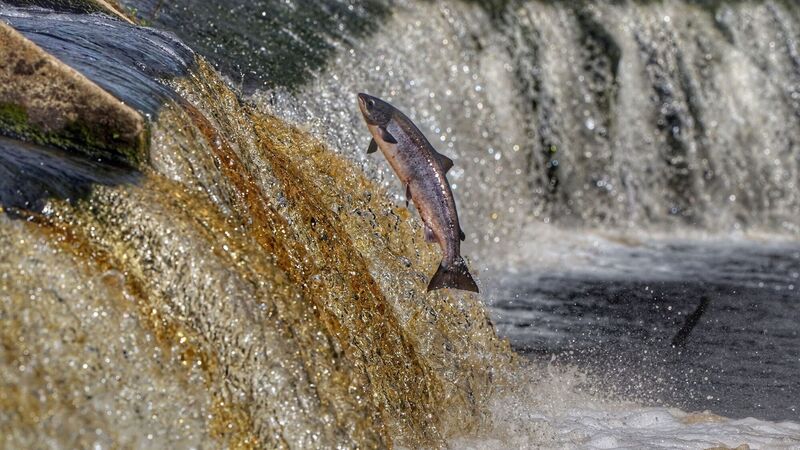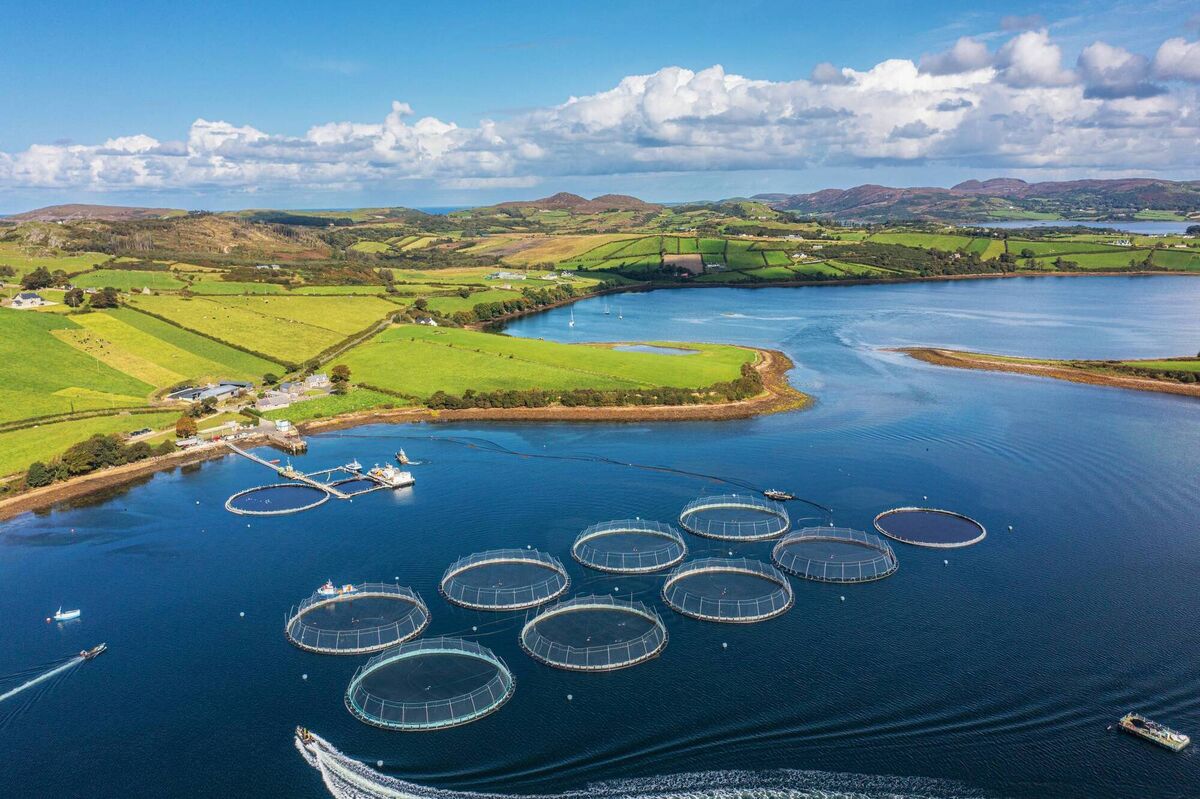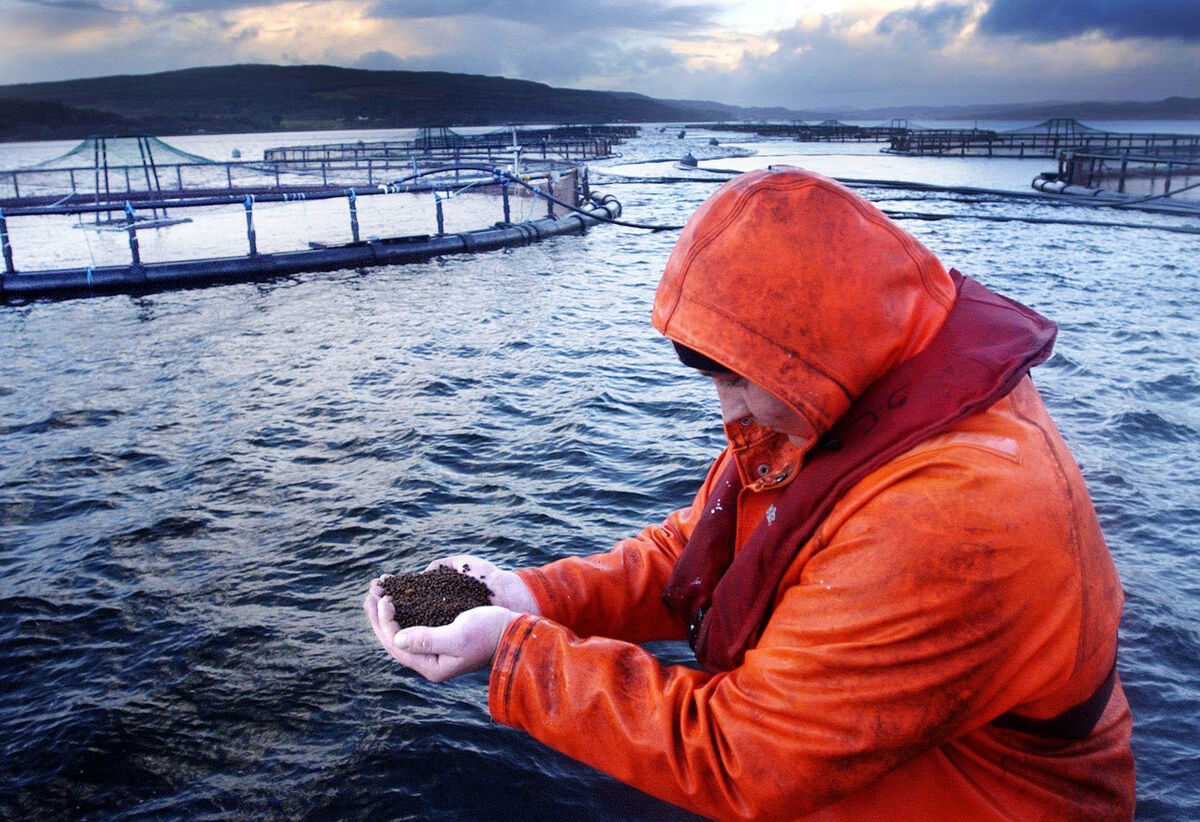The epic migration of Atlantic salmon

A salmon leaps up a weir. In recent years, conservation efforts have been impressive. Picture: Owen Humphreys/PA Wire
Right now, wild Atlantic Salmon are returning to their natal rivers to spawn. They have left behind the rich oceanic upwellings of the north Atlantic, having travelled as much as 3,000 km to return home. The details of how exactly they find their way over such vast expanses of open ocean are still somewhat of a mystery to us, finding their way to the specific estuary, and then river, tributary and stream where their ancestors have been spawning for more than 10,000 years. As a result, the salmon in any given river are those with distinct genetic lineage that is unique to that river.
Each part of the journey has its own challenges to be overcome. After traversing the ocean and arriving in estuarine waters, each returning migrant must spend some time acclimatising in brackish water, as the transition from salt water to sweet fresh water is uncomfortable. Their skin and scales change tone from pure silver to yellows and browns that blend in better with river water, enhancing the chances that they may escape the paws and talons of potential predators.
Travelling upstream against the current, this environment is very different to the marine waters they have likely spent several years in. Here they mingle with minnows, trout, lamprey, and eel, among others. The freshwater invertebrates that sustained them in their youth are no longer appetising, because the salmon returning to spawn stop eating entirely. Instead, they are sustained by the rich reserves of fat built up during years at sea.
Yesterday, for the first time in my life, I had the exquisite, unforgettable experience of seeing wild Irish Atlantic salmon leaping upstream to spawn.
— Eoghan Daltun 🌍 (@IrishRainforest) August 4, 2024
The culmination of a 3,000km journey back to where their lives first began. 🌎 pic.twitter.com/uMe8646zuX
With this energy they can jump up rapids and waterfalls as much as 3 metres high — abilities that have earned them special esteem in our folklore. Perhaps our ancient forbears were aware of the benefits of the rich fatty acids found in salmon flesh that can help our brains to function well, which would explain the logic of the association between salmon, stamina and knowledge.
Each returning salmon will eventually recognise the exact chemical signature of the waters where they themselves were born. November and December are peak spawning times, when those that have made it this far deposit thousands of eggs into a nest, also known as a redd, in the gravel beds of healthy, well-oxygenated river water.
But all along the riverine route, barriers to migration may stop the salmon from being able to reach their spawning beds. Damns, weirds, bridge aprons, and culverts can all act as barriers to migration. For those who do manage to reach their spawning beds, many find the gravel where they lay their eggs all clogged up with excess silt from eroded fields or exposed peat soils, making it impossible to spawn. If the water is polluted, perhaps enriched with excess nutrients from forestry or agriculture, eggs won’t survive or hatch. And these are the challenges faced by those which have already managed to survive at sea, those that have managed to overcome the disorientation of changing ocean currents and escape the ominous nets of industrial trawlers.
All of these impediments have been increasing in severity in recent decades, to such an extent that wild Atlantic salmon are now a critically endangered species. Just 50 years ago, such rates of decline would have been unimaginable, such was the seemingly unending abundance of wild salmon.
#WestHantsFieldTeam complete habitat enhancement at #HockleyMeadows on #RiverItchen, hinging trees into the water. This has already scoured the gravel bed, providing spawning habitat for wild Atlantic Salmon & sea trout. #biodiversity #environment @WinchesterCity @hantsconnect pic.twitter.com/wcHjmLlgTP
— John O'Flynn (@johnoflynnEA) November 10, 2025
In recent years, conservation efforts have been impressive. Angling groups have long been proactive in reinstating spawning beds where dredging had removed them. Community groups and rivers trusts across the country have also been restoring rivers: stabilising river banks to prevent erosion and sedimentation; removing invasive species that leave soils exposed in winter; and planting buffer strips with broadleaf trees to intercept excess nutrients from intensively managed agricultural fields. Yet despite these noble efforts, water quality across Irish rivers is continuing to decline, while our leaders fight instead for the nitrates derogation to continue, an allowance that would certainly counteract community efforts at river restoration.
The epic upstream migration, a symbol of stamina in Irish folklore, is now in jeopardy. The spawning that has taken place each winter since the end of the great Ice Age may or may not continue.

I wonder if 25 years from now, in the year 2050, will there be any wild salmon left to spawn in Irish rivers. If current rates of decline continue, the answer is no. Wild salmon will perhaps be represented instead by a diminished, domesticated version of their kind.
This is what happened to aurochs, the wild cattle that roamed Eurasia and North Africa for more than 250,000 years. Aurochs are the original ancestors of the domesticated cow, celebrated by Palaeolithic people, the Celts, and ancient Romans alike. After millennia of domestication, the last aurochs bull died in 1627, marking the extinction of this species. Now, farmed animals make up 60% of the biomass of all mammals currently on earth, with humans another 36% and wild animals consigned to a measly 4%.

It is hard to imagine now, but could the same fate be awaiting wild fish? Will future generations be left only with stories of how wild salmon once navigated epic migrations across open oceans and up the length of every river in western Europe? Will the only salmon left be those bred in fish farms, those that have lost the ability to navigate a life in the wild?
It will take a great deal of collective commitment to ensure that this is not what we confine the future to, that we can facilitate a viable future for wild Atlantic Salmon. This winter, I know that I'll be taking some time out to spend by salmon river, to watch in awe as salmon swim upstream to spawn.








